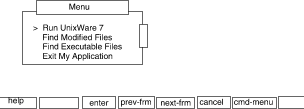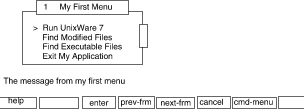
|
|
A menu definition file usually starts with a set of descriptors that pertain to the entire menu, known as frame descriptors. Frame descriptors are optional in menu definition files. If you choose not to define any explicitly, their default values apply to the menu.
The following menu definition file has no frame descriptors, and defines four simple menu items. (Blank lines between logical sections of frame definition files are recommended for readability.)
name="Run UNIX System V" action=unix-systemname="Find Modified Files" action=`find $HOME -mtime -7 -print > modfiles`nop
name="Find Executable Files" action=`find $HOME -perm -100 -print > execfiles`nop
name="Exit My Application" action=exit
Menu.items: an example of menu item descriptors
The first item definition permits the user to
access a full-screen UNIX system shell.
The second item definition runs
find(1)
to locate files whose contents have been
modified within the past seven days and saves the list of filenames in a
file named
modfiles.
The third item runs find to locate files that are executable
by the owner and
also saves the output in a file named execfiles.
The fourth menu item permits the user to exit from the application.
Because no frame or SLK descriptors were defined,
their default values apply:
for example, menu is a frame descriptor used to
define a title for a menu.
Since
Menu.items
did not explicitly define it, the default value
Menu
is displayed in the title bar.
This menu would appear as follows:

Menu.items: screen output
The next example illustrates the use of several frame descriptors in the same menu definition file to change the appearance and add to the functionality of this menu:
menu="My First Menu" begrow=center begcol=30 framemsg="The message from my first menu" help=`message "A help message"`name="Run UNIX System V" action=unix-system
name="Find Modified Files" action=`find $HOME -mtime -7 -print > modfiles`nop
name="Find Executable Files" action=`find $HOME -perm -100 -print > execfiles`nop
name="Exit My Application" action=exit
Menu.frame: an example of menu frame descriptors
The first group of descriptors are the frame descriptors.
The frame descriptor
menu
defines a title for the menu,
My First Menu.
The
begrow
and
begcol
descriptors define the position of the top left corner of the frame
in the work area.
In this example, the top left corner of the frame will be located at the vertical
center of the work area, and column 30 horizontally.
The
framemsg
descriptor defines a string that will appear on the message line
when the frame is opened.
It will remain on the message line until the frame is closed or
made non-current (although it
can be temporarily replaced by other, shorter-term messages).
The
help
descriptor defines what will happen when a user requests help while
the menu is active.
In this example, the string
A help message
will be displayed on the message line.
``Menu.frame: screen output'' shows how Menu.frame will be displayed after these frame descriptors have been defined.

Menu.frame: screen output